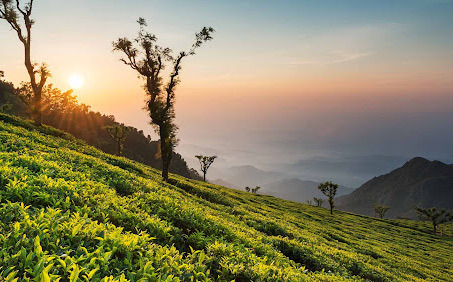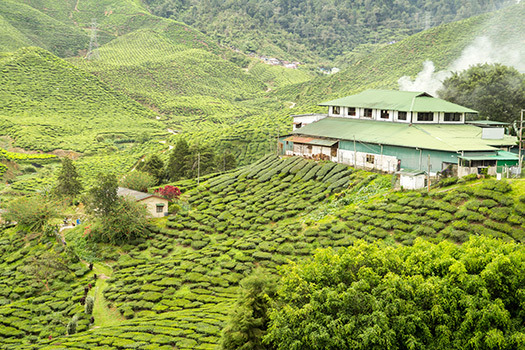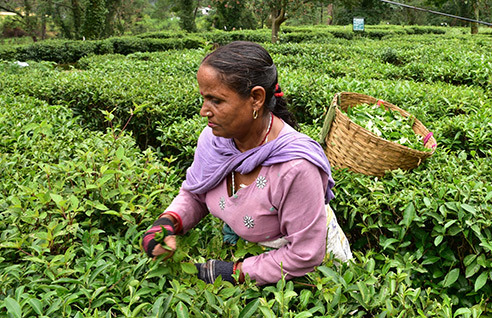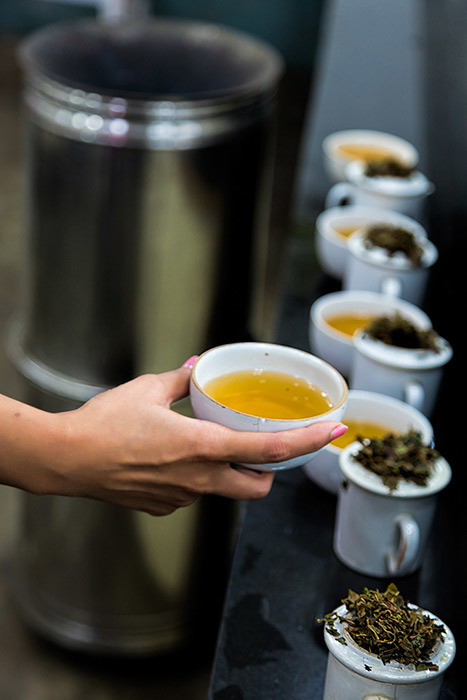JORHAT, ASSAM:

Popular as a breakfast tea, Assam tea is well-known for its malty taste. While green teas and white teas are also produced here, it is famous for the black tea produced in higher quantities. Having an advantage of lowlands, it is one of the world's largest tea-growing regions. The leaves of Assam tea are almost double the size of Darjeeling tea. A unique system that is still followed in Assam tea gardens is its work time. Considering the early sunrise in this region, the British formed a system wherein they set the local time one hour ahead of IST (Indian Standard Time) and called it “Tea Garden Time” or Bagan time. Unlike Darjeeling tea, Assam Tea is harvested in two flushes only, between March and November. Another characteristic of Assam tea is that the final flush gives the superior quality tea here.
In contrast to it, Darjeeling tea received in the first flush is considered superior. Assam tea is believed to boost energy and mental alertness. Some studies also link Assam tea's consumption to reduce cancer risks.
Have a glimpse of an Assamese Tea garden.
Jorhat is not only famous for the world's oldest and largest tea research center- Tocklai Experimental Station (that later became Tocklai Tea Research Association), but it is also well known for the country's only wildlife sanctuary to spot the Hoolock Gibbons - Hoollongapar Wildlife Sanctuary. It can also be combined with a visit to the tribal villages around it to know about their culture, and surprisingly, some of them are still practicing traditional methods of making tea. Another major attraction of the town is the Annual Tea Festival, which is celebrated between November and January and attracts visitors from all over the world.
FUN FACT: Today, Tea is like a part of every home’s routine in India but do you know it was not accepted by the locals in India, initially? It was only after many years of promotion, they got used to it.
COONOOR AND OOTY – NILGIRIS, TAMIL NADU:

Grown in the Nilgiri Hills in the Western Ghats mountain region, Nilgiri tea is known for its dark and aromatic characteristics. Although it comes third to Darjeeling and Assam tea, but it is quite popular among North Americans. After getting success in Darjeeling and Assam, the British experimented with planting tea at many other places across India to increase the production, and Nilgiri's soil was found suitable for the same. The climatic conditions of the region attribute to its fragrance and flavor.
As Nilgiris tea also originated from the Chinese seeds used in Darjeeling, it is also harvested in 03-04 flushes. Antioxidants, catechins, and polyphenols present in this tea help combat many health problems like heart diseases, cancer, high blood pressure, etc.
Coonoor and Ooty are among the places best known in the Nilgiris for their tea gardens. The best way to enjoy the breath-taking views of its peaks and the vegetation is to board the meter gauge toy train Nilgiri Mountain Railway, a part of the UNESCO listed Mountain Railways of India. It's not only the surroundings that attract but also the weather that is mostly cloudy, drizzling, and cool add to the charm here. Imagine the thrill of trekking in such a beautiful canvas of nature.
FUN FACT: You must be wondering why Teas are grown on sloping hills only. It is to allow the natural drainage of water, as it cannot survive stagnant water.
MUNNAR, KERALA:

Unexplored until the 1870s, Munnar was noticed by the British officer John Daniel Munro. He was so mesmerized with this wild and virgin region that he took it on lease from the royal family who possessed it. After trying some other crops, he finally realized the soil's potential for tea plantation, and thus we got another tea plantation.
Its higher altitude contributes to its taste and biscuit-like aroma, though the origin is the same as of Darjeeling or Nilgiri teas. This place also hosts “India's first tea museum” that imparts a lot of knowledge about the journey of tea from the plantation to your cup.
When in Munnar, you can explore multiple treks that start from the tea plantations leading to hilly peaks offering breath taking views. Gushing streams and waterfalls around it also garnish the beauty of Munnar. While a visit to the Tea plantation and tea factory will give an insight into how tea is grown and processed before it reaches your cup, a visit to the Tea Museum will take you back to its history as well.
FUN FACT: If you are travelling in a train in India, the most loudly heard vendor you will find on train platforms is a Tea vendor (Chai Wala as called locally).
PALAMPUR, HIMACHAL PRADESH:

Not very far from the famed Dharamasala (Home to Dalai Lama the spiritual leader of the Tibetan), a small hill town Palampur has several lush green tea gardens. Surrounded by the spectacular Dhauladhar ranges, Palampur is known as the tea capital of Northwest India. Here, the production of tea's superior form with unique color and flavour is attributed to the region's climate and geographical conditions. The majority of tea cultivated here is black tea with a very small proportion of Green tea.
The tea plantations here were also a part of the British's experiment drive to increase the tea production area in India using hybrid Chinese seeds. The whole setting with hills carpeted with tea plantations, pine trees in the background and aroma of tea mixed with cool breeze will take you to another world.
Palampur is also known for some beautiful trekking trails and paragliding at a nearby place called Bir-Billing that is said to be among the best paragliding sites in the world. Another draw is the Kangra Toy Train that is a beautiful ride to absorb the natural beauty as many a time it crosses villages, cutting through fields or brushing a compound wall. An important highlight here is to explore the surroundings and visit some of the most famous temples.
Come and explore these beautiful tea gardens surrounded by adventure, nature, and divine flavours.
At Indo Asia Tours, the itinerary is not just a travel route or a trip. We design, conceptualise and handcraft every journey for you. Our special customised itineraries and curated experiences in different destinations are what make for those memorable travel moments.


 Darjeeling tea is the most sought after amongst all the teas found in India because of its quality. Its unique flavour and aroma is attributed to its higher altitude. The teas produced here are believed to be grown at the highest elevation in the world. While the use of machines, modern fertilizers, and pesticides helps in rapid production, it also leads to problems in the hilly region like slope instability, soil erosion, and depletion.
Darjeeling tea is the most sought after amongst all the teas found in India because of its quality. Its unique flavour and aroma is attributed to its higher altitude. The teas produced here are believed to be grown at the highest elevation in the world. While the use of machines, modern fertilizers, and pesticides helps in rapid production, it also leads to problems in the hilly region like slope instability, soil erosion, and depletion.
 Popular as a breakfast tea, Assam tea is well-known for its malty taste. While green teas and white teas are also produced here, it is famous for the black tea produced in higher quantities. Having an advantage of lowlands, it is one of the world's largest tea-growing regions. The leaves of Assam tea are almost double the size of Darjeeling tea. A unique system that is still followed in Assam tea gardens is its work time. Considering the early sunrise in this region, the British formed a system wherein they set the local time one hour ahead of IST (Indian Standard Time) and called it “Tea Garden Time” or Bagan time. Unlike Darjeeling tea, Assam Tea is harvested in two flushes only, between March and November. Another characteristic of Assam tea is that the final flush gives the superior quality tea here.
Popular as a breakfast tea, Assam tea is well-known for its malty taste. While green teas and white teas are also produced here, it is famous for the black tea produced in higher quantities. Having an advantage of lowlands, it is one of the world's largest tea-growing regions. The leaves of Assam tea are almost double the size of Darjeeling tea. A unique system that is still followed in Assam tea gardens is its work time. Considering the early sunrise in this region, the British formed a system wherein they set the local time one hour ahead of IST (Indian Standard Time) and called it “Tea Garden Time” or Bagan time. Unlike Darjeeling tea, Assam Tea is harvested in two flushes only, between March and November. Another characteristic of Assam tea is that the final flush gives the superior quality tea here.
 Grown in the Nilgiri Hills in the Western Ghats mountain region, Nilgiri tea is known for its dark and aromatic characteristics. Although it comes third to Darjeeling and Assam tea, but it is quite popular among North Americans. After getting success in Darjeeling and Assam, the British experimented with planting tea at many other places across India to increase the production, and Nilgiri's soil was found suitable for the same. The climatic conditions of the region attribute to its fragrance and flavor.
Grown in the Nilgiri Hills in the Western Ghats mountain region, Nilgiri tea is known for its dark and aromatic characteristics. Although it comes third to Darjeeling and Assam tea, but it is quite popular among North Americans. After getting success in Darjeeling and Assam, the British experimented with planting tea at many other places across India to increase the production, and Nilgiri's soil was found suitable for the same. The climatic conditions of the region attribute to its fragrance and flavor.
 Unexplored until the 1870s, Munnar was noticed by the British officer John Daniel Munro. He was so mesmerized with this wild and virgin region that he took it on lease from the royal family who possessed it. After trying some other crops, he finally realized the soil's potential for tea plantation, and thus we got another tea plantation.
Unexplored until the 1870s, Munnar was noticed by the British officer John Daniel Munro. He was so mesmerized with this wild and virgin region that he took it on lease from the royal family who possessed it. After trying some other crops, he finally realized the soil's potential for tea plantation, and thus we got another tea plantation.
 Not very far from the famed Dharamasala (Home to Dalai Lama the spiritual leader of the Tibetan), a small hill town Palampur has several lush green tea gardens. Surrounded by the spectacular Dhauladhar ranges, Palampur is known as the tea capital of Northwest India. Here, the production of tea's superior form with unique color and flavour is attributed to the region's climate and geographical conditions. The majority of tea cultivated here is black tea with a very small proportion of Green tea.
Not very far from the famed Dharamasala (Home to Dalai Lama the spiritual leader of the Tibetan), a small hill town Palampur has several lush green tea gardens. Surrounded by the spectacular Dhauladhar ranges, Palampur is known as the tea capital of Northwest India. Here, the production of tea's superior form with unique color and flavour is attributed to the region's climate and geographical conditions. The majority of tea cultivated here is black tea with a very small proportion of Green tea.
 We can conduct a virtual destination awareness training program for your team or yourself or a virtual tour for your clients. Let us know the destination of your interest along with your convenient date / time and we will be happy to set up a program for you.
We can conduct a virtual destination awareness training program for your team or yourself or a virtual tour for your clients. Let us know the destination of your interest along with your convenient date / time and we will be happy to set up a program for you.



